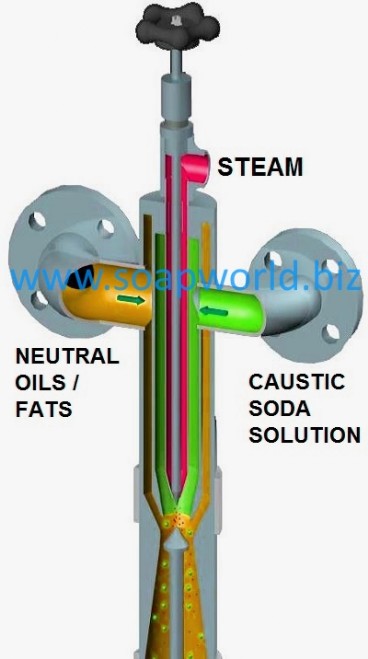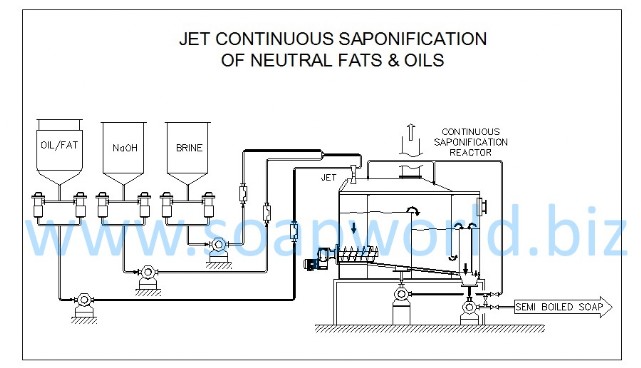6e. JET Saponification Plant
Soap Manufacturing > 6. Industrial Soap Manufacturing
JET SAPONIFICATION PLANT for SEMI BOILED SOAP
The JET is a device studied to improve the saponification process. Vegetable oils / animal fats and caustic soda solution enter in the JET device in the correct proportions. The main feature of the JET is the immediate start of the reaction in a very small volume, internal to the JET. Thanks to the energy passed by a small flow of live steam (kinetic and thermal), the pumped reagents (oil blend and alkali) immediately form a stable homogeneous emulsion which flows out the JET.
The emulsion consists of freshly produced soap, oil, alkali, water etc. In such environment the reagents continue to saponify without any additional supply of energy.
In a conventional saponification process the initial reaction is slow, while with the JET such stage is immediately completed and the saponification easily reaches its linear reaction phase.
In a conventional saponification plant the use of a two concentrated caustic soda solution (i.e. 50% NaOH) brings to a non-homogeneous soap mass. Furthermore such soap tends to be highly viscous and cannot be easily pumped in continuous reactors based on high recirculation processes. These facts determine a lower limit of water content into the neat soap.
In a JET saponification, this lower limit can be sensibly reduced thanks to the formation of a stable emulsion in a very small volume.
Simultaneously to the supply of the reagents, the JET receives a small flow of steam of which, flow and pressure, can be fine tuned for the formation of the best emulsion.
JET SAPONIFICATION PLANT, BATCH TYPE for SEMI BOILED SOAP
Raw materials are pumped, in correct proportions, through Filters into the Saponification Jet by a Dosing Group consisting of gear pumps and flow-meters. The reaction between the ingredients starts in the Jet and continues into the Crutcher where the saponification is completed and, if required, fillers are added at the end of the saponification reaction.
The final Soap Moisture content is determined by the concentration of caustic soda solution. The combination of the Jet and the crutcher allows the start of the saponification process even with high concentrations of caustic soda therefore it is possible to obtain a semi boiled soap with 12% of moisture.
CONTINUOUS JET SAPONIFICATION PLANT for SEMI BOILED SOAP
Raw materials are dosed in correct proportions through Filters to the JET and finally to the Continuous Saponification Reactor by a Dosing Group consisting of gear pumps and flow-meters.
The saponification starts in the specially designed Emulsifying JET where the oil blend and the alkali immediately start reacting and generate an emulsion (oil-alkali-soap) discharged in the multi-stage Reactor at atmospheric pressure. Here the generated emulsion, in form of creamy foam, completes the reaction by slowly flowing through the various stages.
Also in this case the final Soap Moisture content is determined by the concentration of caustic soda solution, so it is possible to obtain a semi boiled soap with 12% of moisture.
Steam Injection has several functions:
- Provides the necessary kinetic power to generate a great emulsionated interphase.
- Triggers the saponification reaction providing the required thermal energy.
- Immediately increases the relative electrolytes percentage so as to allow sudden generation of enough
The JET saponification device allows the production of Concentrated or Semi Concentrated Soap. Practically it produces a neat soap with the preferred moisture level, avoiding the addition of process water which would be then expensive to evaporate.
A JET saponification plant to produce soap noodles can be completed with a Drying Plant (Drying and Cooling Section) or with a simpler and more economical Cooling Section based on a Chill Rill (also called Drum Flakers). The Chill Roll option can produce semi boiled laundry and even toilet soap. The JET is a device that can be used in Semi Boiled processes in combination of an Atmospheric Continuous Reactor or a Batch Crutcher as well as in Full Boiled plants assembled on top of the Kettles.
FINAL
CONSIDERATIONS ABOUT THE JET
The JET technology requires a minimum steam consumption of about 100
kg/h each 1,000 kg/h of produced soap. The maintenance is simple and minimum.
The JET has no moving mechanical parts; the pumps are the only moving parts of
the process.
In the Full Boiled processes the process water is abundantly used and
remains into the soap. A typical concentration of full boiled soap is 62% TFM
and 33% water.
A Semi Boiled soap obtained with a conventional plant has a typical
concentration of about 58-60% TFM (glycerin excluded) and 28-30% water. The
high content of water is necessary to facilitate the saponification and obtain
a homogeneous soap mass.
The JET Semi Boiled saponification allows the production of neat soap at
a very wide range of concentrations. It is possible to produce soap at 58% TFM
as with a conventional plant and it is possible to produce:
- SEMI CONCENTRATED SOAP – With a water content in the range of 20%, the soap can be just cooled down, without any evaporation, in order to obtain Laundry Soap or it can be processed by a Drying Plant with reduced Heat Exchanger and reduced Vacuum Section in order to evaporate a limited quantity of moisture and obtain Semi boiled Toilet Soap.
- CONCENTRATED SOAP – With a water content from 16% down to 12% there is no further scope of drying and the soap is to be cooled down in order to obtain Semi boiled Toilet Soap. A compact Chill Roll plant is the ideal soap cooling device to complete the process without the need of a more complex and consuming Drying Plant.


